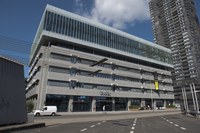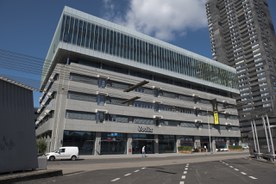Climate resilient retrofit of a Rotterdam building

The old office building at Groot Willemsplein, Rotterdam, dating back to the 1940’s, was renovated to give it a new life with commercial functions on the ground floor and flexible office spaces at the other floors. The most important climate adaptation and mitigation measure implemented is the energy-efficient cooling and heating system. An Aquifer Thermal Energy Storage (ATES) system supplies the building with heat and cold. In summer, heat will be absorbed and stored in a ground water aquifer, this stored heat can be used in winter to heat the building. During the summer period cold water from another part of the aquifer is pumped up to cool the building. In this way the infrastructure is associated with climate adaptation (being prepared for increased cooling needs in summer in a sustainable way) and mitigation (reduced emissions of carbon dioxide). The additional heat that is needed comes from district heating (excess heat from nearby industry). The rooftop garden is a further implemented adaptation measure dampening the effect of more frequent heavy showers; in addition it is an attractive recreational green space with special attention for birds, bats and insects.
Case Study Description
Challenges
Cooling needs in summer are expected to increase as a consequence of higher temperatures due to climate changes. The main climate adaptation challenge was therefore the protection of the interior of the building from excess heat in this season. Proposed solutions to renovate the office building also aimed to create synergies between adaptation and mitigation solutions; the main climate mitigation challenge was to become highly energy efficient, thereby saving energy consumption.
Objectives
The objective was to develop a sustainable and attractive office building that fits in the area, making use of the existing infrastructure as much as possible, and including synergic mitigation and adaptation solutions to climate change, in particular related to the building cooling system. Groot Willemsplein is a central location in Rotterdam that serves as an entrance to the city, a location for small events, and a hub for water transportation and is part of a green zone for recreational purposes. To guarantee a contribution to a lively area the ground floor of the building had to have a commercial function and could not be used as offices.
Adaptation Options Implemented In This Case
Solutions
With regard to climate change adaptation, the use of an ATES (Aquifer Thermal Energy Storage) system and a green roof are the most important implemented solutions. In particular:
- ATES was used for cooling in summer and heating in winter. In summer, the cooling is fully dependent on ATES. For heating in winter, ATES contributes to 30-50% of the heat, for the remaining 50-70% use is made from the district heating system which uses excess heat from nearby industry. This was the most feasible solution for this building. The use of ATES has enabled an overall CO2 reduction of 11.4% with respect to district heating alone. When only the heating/cooling system is considered, the CO2 reduction is 45%, mainly due to more sustainable cooling in summer.
- A rooftop garden serves as rain water buffer. In addition it is an attractive recreational area for people from the offices and it serves as a habitat for insects, birds and bats.
Other sustainable solutions not strictly related to climate change adaptation that were implemented in the renovation of the office building are highlighted in the following points:
- The skeleton of the existing building was used as much as possible. The upper floor that was added later and the interior of the building were demolished, but the construction was maintained. In this way optimal use was made of the available material. The old building contributes 57% of the material volume of the new building.
- The original construction was strong enough to be reused and, with modifications, to serve as a basis for the new construction with three extra floors in a lightweight construction.
- Triple glazing of the new floors was used to reduce heat losses.
- Transparent facades and an atrium give an optimal use of day light.
- To make optimal use of the space, the offices of the main tenant contain flexible places to work in open offices, with spaces to retreat for phone calls and meetings. Sensors for day light and sensors for presence reduce the use of artificial lighting.
The result of all adopted measures together is that the energy consumption is 63% lower than the average office building in The Netherlands.
Relevance
Case developed and implemented and partially funded as a Climate Change Adaptation measure.
Additional Details
Stakeholder Participation
Stakeholder participation was not directly relevant for the renovation of the office building. The following key actors are involved in the project. The company Joulz working in the field of gas and electricity infrastructure selected the building for its new headquarter offices. Joulz had explicit requirements for sustainability and currently is the main tenant, occupying the lower 3 office floors. LSI Project Investment, Rotterdam, was owner of the building and commissioned the renovation. Gemeente Rotterdam is not a formal stakeholder but required a commercial use of the ground floor which now includes a restaurant.
Success and Limiting Factors
The main tenant of the offices, Joulz company, initiated the process and explicitly wanted a sustainable building for their headquarters. Joulz was enthusiastic about the location of the building and saw the potential to transform it into a building that matches with its sustainable business goals.
Although it is an old building, the project developers have made maximum use of the original infrastructure by upgrading the parts that can be kept and replacing the other parts by well-insulated alternatives. However, the decision to make use of the existing construction reduces the flexibility of the design of the building and therewith the possibilities to implement sustainability measures in a cost-efficient way.
Costs and Benefits
Total costs of the whole project was 10 million Euro. The project was fully funded by a private company. ATES would cost 531.877 Euro as compared to 252.994 Euro for a conventional system, but saves 23.882 Euro per year. Moreover, there is a small refund of 10% on the investment costs for a sustainable installation. The investment in ATES would be returned in about 9.5 years.
Legal Aspects
There is a municipal requirement that the ground floor contributes to the public space and is not used as an office.
Implementation Time
2 years: 2011-2013.
Life Time
15-30 years; lifetime of technical installations is shorter than that of building as a whole.
Reference Information
Contact
B. Kortekaas
Stedin (formerly at Joulz)
Postbus 49
3000 AA Rotterdam
Tel.: +31 (0) 6 53764708
Websites
Reference
EEA Study “Examples and case studies of synergies between adaptation and mitigation and between incremental and transitional approaches in urban areas”.
Published in Climate-ADAPT Jun 07 2016 - Last Modified in Climate-ADAPT Apr 04 2024
Please contact us for any other enquiry on this Case Study or to share a new Case Study (email climate.adapt@eea.europa.eu)


